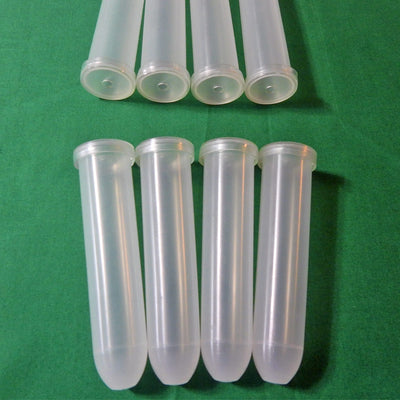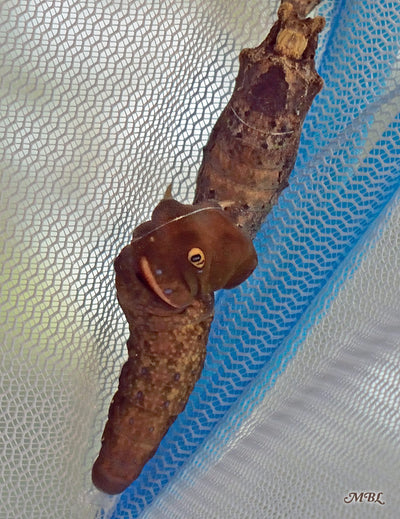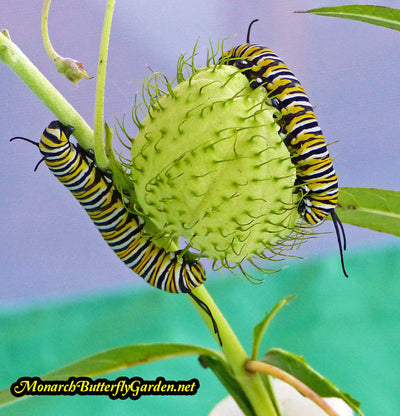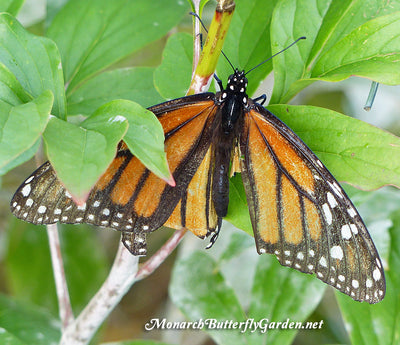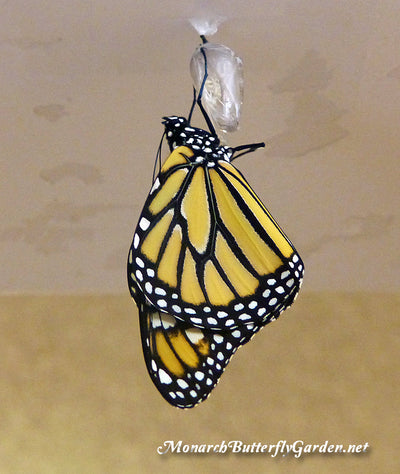Raising Butterflies Blog
How to Raise Monarch Butterflies Indoors: 21 Monarch Survival Tips
Raising monarch butterflies from eggs isn’t rocket science, but a bad raising process can end up hurting the monarchs you thought you were helping. Here are 21 tips to help you raise healthy monarch indoors...

Raising Healthy Monarch Butterflies Inside

Raising monarch butterflies from eggs isn’t rocket science, but a bad raising process can end up hurting the monarchs you hoped you were helping. Here are 21 tips to help bring you more raising success, while helping the monarchs recover from their 90% decline.
How To Raise Monarch Butterflies Indoors- Preparation Tips
Preparation Tip 1- Keep It Real
Keep your monarchs in an environment that brings all the benefits of nature without the dangerous extremes. We keep our caterpillars in a breathable mesh cage in our three-season porch with the windows open.
This exposes growing monarchs to natural heat and humidity levels without exposing them to high winds, heavy rains, and blistering sun…
Preparation Tip 2- Don’t Focus on Monarch Diseases, Focus on Disease Prevention
A large % of people that post comments on this blog, ask questions about monarch diseases and how they can cure them. The bad news is, you can’t. The good news is, a proven raising process will largely eliminate the raising conditions that cause monarch disease.

A journal is a great way to reflect on the season and see how you’ve progressed. It’s also a tool you can use to help determine the cause of issues that arise during the raising process.
Find a Monarch Butterfly Journal Here
Preparation Tip 3- Use a Butterfly Cage designed for Raising Caterpillars
We use breathable mesh cages that keep caterpillars in, and deadly predators out. Most alternatives have holes that baby monarch caterpillars can easily escape from. When a caterpillar hatches it’s less than 1/10″ long, and can slip through most makeshift cages. If a baby caterpillar escapes, it’s like finding a needle in a haystack…maybe worse.
Supply List for Raising Monarch Butterflies
Preparation Tip 4- Don’t Mix Cats with Cats…or Dogs!
Unfortunately, some of our curious feline friends don’t mix well with butterfly ‘cats’ and could kill the monarchs you’re trying to protect.
If you’re lucky, your pet will only sniff them, like our dog does. If your pet is more paws on, make sure your raising cage is out of harm’s way.
Preparation Tip 5- Don’t Mix Caterpillars with Butterflies
Butterflies can spread parasites to caterpillars so they shouldn’t be kept in the same cage. Raise one batch of monarchs at a time and don’t collect more eggs until the last butterfly is released, and your cage has been cleaned. Your other option is to keep two raising cages on hand.
Preparation Tip 6- No Chemical Use
Don’t use household cleaners, apply flea treatments, lotion, hairspray, or hand sanitizers around your monarch guests, as these can prove deadly. If you’ve handled these (or similar) items, please wash/dry your hands before handling milkweed or monarchs. Don’t forget to wash after petting a flea treated dog!
How To Raise Monarch Butterflies Inside- Milkweed Tips
Milkweed Tip 7- Grow a patch of milkweed before you start raising monarchs
In its two week life span, one caterpillar can consume an entire milkweed plant. Do yourself a favor and have plenty of milkweed available before you begin.
A patch of milkweed should consist of 6-10 mature plants for feeding hungry monarch caterpillars. Grow at least 2-3 different species of milkweed, and grow several patches (and mini-patches of 2-3 plants) around your yard/garden if possible.
If you are picking milkweed leaves from another location, find out if they’re being treated with pesticides or are scheduled for a date with the city mower!
Find Milkweed for your Butterfly Garden
Milkweed Tip 8- Use Milkweed Cuttings: the Goldilocks of Milkweed Meals
 Fresh for Days
Fresh for DaysLarge potted plants give hitchhiking predators too many hiding places. Individual leaves dry out too quickly…but milkweed cuttings make the perfect monarch meal.
You can use food containers, vases, or floral tubes/picks to hold your cuttings. Use egg cartons, styrofoam lids, sturdy plastic cups, or floral tube holders to keep the tubes upright:
 Keep your Milkweed Fresh…for Days!
Keep your Milkweed Fresh…for Days! Find Floral Tubes and Holders for Feeding Caterpillars
Milkweed tip 9- Plan for Milkweed Emergencies
If you’re just learning how to raise monarch butterflies indoors, you haven’t experienced your first milkweed emergency…yet!
Milkweed emergencies occur when your heart brings in more eggs/caterpillars than your can milkweed can handle, and you run out of must-have monarch meals.
Know your emergency options including nearby parks, neighbors, and nurseries that carry pesticide-free milkweed plants.
Milkweed Tip 10- Wash Your Hands
The sap from milkweed is toxic and can cause corneal damaged if rubbed into your eyes. Always wash your hands after handling milkweed.
This is also a good rule of practice before handling monarch caterpillars, in case there’s something on your hands that could be toxic to them or spread disease.
How To Raise Monarch Butterflies Indoors- Tips for Monarch Eggs
Egg Tip 11- Start Small

If you want to avoid diseases and parasites bring in monarch eggs instead of caterpillars. This means you’ll never have to deal with tachinid fly larvae emerging from your caterpillars:
You can also greatly decrease the risk of tachinid parisitoids by bringing in small instar 1-2 monarch caterpillars.
Egg Tip 12- Set Limits and Stick to them
You can’t save all the monarchs and that shouldn’t be your raising goal if you want to raise healthy monarchs and promote a healthy local ecosystem. Set a goal and once you reach it…stop looking for eggs!
Raise a few monarchs, and raise them well…
Egg Tip 13- Where to Find Monarch Eggs?
Lucky for us, monarchs have one-track minds, and only lay eggs on milkweed plants. Since they are a migratory species, they’ll lay eggs on almost any milkweed variety. Where should you look to find eggs on milkweed?
- look for monarch eggs when skies are overcast…glare from the sun makes seeing them difficult
- bottom of leaves
- inside flower buds
- tops of leaves
- milkweed stalks
- milkweed pods
- plants or grass growing right next to milkweed
- fresh milkweed- monarch females often lay eggs on plants just a couple inches high including seedlings and returning perennials
- partial-shade milkweed puts out lush growth and fas fewer patrolling predators
- lone milkweed plants also attract less attention from predators
Egg Tip 14- Keep Monarch Eggs in a Hatchery
If you retrieved monarch eggs on individual leaves keep them in a container or cage with increased humidity so the leaves won’t dry out. The first two options in this post make good hatcheries:
How To Raise Monarch Butterflies Indoors- Tips for Raising Monarch Caterpillars
Caterpillar Tip 15- Monarchs Need Water

Milkweed should be thoroughly rinsed so that caterpillars food is clean, while providing extra hydration. A mesh cage provides good air circulation so mold shouldn’t be an issue.
Caterpillar Tip 16- Separate small caterpillars from big brothers/sisters
Don’t put large instar 4-5 caterpillars next to small instar 1-2 caterpillars or the babies could end up becoming part of a milkweed meal.
Caterpillar Tip 17- Clean your Cage Daily
A dirty, frass-filled cage can be the catalyst to spreading disease, so clean regularly. For large caterpillars, you can easily clean up their frass (poop) with a low-power keyboard vacuum.
Cordless Keyboard Vacuum Cleaner (we use the black version offered by several vendors)
Caterpillar Tip 18- Don’t Overcrowd your Cage
Our raising cages are 2ft wide by 2ft long. We can fit about 30 caterpillars in each cage without worrying about crowding them. For 30 caterpillars we would use 6-8 cuttings containers. How many containers you use ultimately depends on the size of each milkweed cutting and size of your monarch caterpillars.
How To Raise Monarch Butterflies Inside- Monarch Chrysalis Tips
Chrysalis Tip 19- Place Green Carrying Handles Across Cage

Sometimes a monarch caterpillar will crawl across the cage frantically looking for that perfect place to form its chrysalis. By placing the green cage handles across the cage roof, it provides them a secure spot to hide their chrysalis, similar to pupating under a leaf outdoors...just don't tell them you can still see them 😉
Chrysalis Tip 20- Don’t Touch That Chrysalis!
Don’t ever try moving a monarch caterpillar that is hanging upside down to form a chrysalis, or has spun a silk pad to hang from. This is arguably the most fragile time in the monarch life cycle.
How To Raise Monarch Butterflies Indoors- Butterfly Release Tips
 Protect Your Butterflies
Protect Your Butterflies
Release Tip 21- Let Butterflies Dry
Newborn butterflies must dry their wings at least 2-3 hours before they’re released. Otherwise, they’ll be defenseless against predators and/or territorial monarch males. In fact, monarch males are notorious for snatching new females for mating before their wings are dry!
Sun dry butterflies outside in a mesh enclosure to energize monarchs for release.
If you want to learn the exact process I use to raise monarchs indoors with a 95% survival rate, sign for my free newsletter below:
I hope you enjoyed 21 Tips on Raising Monarch Butterflies.

